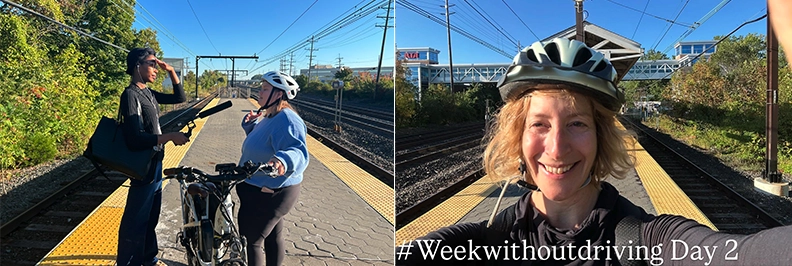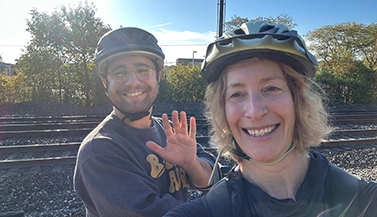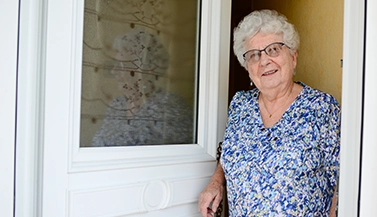My Week Without Driving: Adventures of a Midlife Transit Rookie
I learned about the week without driving challenge about two months ago — maybe longer. I saw a post on LinkedIn (because, let’s be honest, it’s pretty much the only social platform I use) and thought, huh, that sounds interesting. A follower even encouraged me to tie it into my work at STC. My brother had just completed a cross-country EV trip from Austin to Olympia, WA, documenting every charging station and scenic overlook like a sustainable travel influencer. If he could make people care about kilowatts and charging ports, surely, I could make bus stops sound…..mildly interesting.
Sure, I’m not a social media maven. Facebook? Rarely. Instagram? STC has one, but I can’t even remember the password. The idea of posting selfie videos makes my stomach turn. Still, I figured, why not? I spend most of my day helping people who don’t drive. Time to put myself in their shoes.

Preparing for the Week Without Driving: The Pre-Game Panic
As the start date neared, the thing that filled me with the most dread wasn’t the logistics or the weather (which happened to be fabulous, by the way) — it was the bike rack on the front of the RTA bus. I’d heard it was easy, but the idea of holding up a line of honking commuters while I fumble with metal bars and pedals was deeply humbling.
Thankfully, my friend and Cuyahoga County’s Senior Advisor for Transportation, Annie Pease, reached out to ask if I was still planning to do the challenge. I admitted my fear of public bus-bike humiliation. She suggested connecting with Bike Cleveland — might be a nice way for them to get some promotion during the week. (Spoiler: they did. And yes, I survived.)
Day 1: Kicking Off the Week Without Driving with a Bus Adventure
The week without driving kicked off the same day as the On the Move: Senior Transportation Fair, which felt perfectly poetic. After all, “livable communities” aren’t just for seniors — they’re for everyone who uses wheels, walkers, strollers, or their own two feet. They’re for the people who don’t have a car, and for those of us realizing how much we take our cars for granted.
So, I set out: caught the 26 on Detroit, transferred at Public Square to the 19, and rumbled down Broadway toward Miles Road. The QR code for my fare didn’t work (naturally), but the driver just waved me on. It was a bumpy ride —a reminder that not all streets are created equal — but I made it. It was also a reminder of how STC’s riders sometimes feel in an aging vehicle while STC competes for vehicle replacement funding from NOACA(our regional planning agency). Across the street from the FrederickDouglass Rec Center, I felt like I’d just conquered Everest.
Day 2 & 3 Logistics of the Week Without Driving Challenge
Day 2: The Bike + Rapid Combo
Today’s commute involved Jenna Thomas and Jack Brancatelli from Bike Cleveland — and my trusty (slightly dusty) bike. We rode to the rapid station, took the elevator down, and rolled onto the train like pros. I learned that the area reserved for wheelchairs is also where bikes can go, which raised a quiet moral dilemma: what happens if someone actually needs that space? These are the tiny details you never think about until you stop driving.
After a long but satisfying journey, I made it to work — then hitched a ride with my Board Chair to a meeting in North Olmsted. (According to the official rules of the week without driving, getting a ride is totally acceptable. Good thing, because my next bus option would’ve taken an hour and forty minutes.)
Day 3: The Faith-in-Humanity Bus Ride
By Day 3, I was tired. Really tired. My backpack had become a black hole of snacks, receipts, reading glasses, and lost chapstick. While waiting for the bus, a young woman asked if I had a few dollars so she could buy breakfast. I gave her a $20, and asked her to bring back the change – like her mother. I mean – who does that? But there was something about her that made me like and trust her. A few minutes later, she came back — McDonald’s in hand, and my change in the other. My faith in humanity restored.
The rest of the day went smoothly — work, then Yom Kippur services at sunset. As I walked to the Maltz Performing Arts Center for services, having taken the 26 (again) and the RTA Healthline to E. 105th and Euclid, the evening light felt especially meaningful. I’d traveled all day, seen the city from the ground up, and arrived right on time — car-free.
Day 4 & 5 Reflection and Relapse During the Week Without Driving
Day 4 was a driving reprieve — or rather, a chauffeured one. Yom Kippur meant rest, reflection, and no transportation anxiety, though at this point, I was feeling like a pro.
By Day 5, my carefully planned routes began to collide with reality. I had back-to-back meetings — Lyndhurst, City Hall, La Place, downtown, and a looming grant deadline. I wanted to be the hero who powered through, but instead, I drove.
And you know what? The folks at America Walks, who started the #weekwithoutdriving, say using your car isn’t a failure — it’s a time to reflect. And they’re right.
Final Thoughts on the Week Without Driving
A week without driving made me appreciate how much privilege sits in my car keys. What was an “experiment” for me is daily life for thousands in our community. It reminded me that mobility isn’t just about transportation — it’s about freedom, equity, and belonging. It’s also about maintaining one’s health and well-being – hence, the tens of thousands of trips STC provides to the doctor each year.
By the end of the week without driving, I was tired, a little proud, and a lot more aware.
Also, my week without driving would not have been possible without the great team at STC. During the week, I spent less time working (at the office) and more time riding the bus, riding my bike, and walking. Having this time to myself was great - but it also meant losing time at the office. Fortunately, the STC team knows what it’s doing to keep the wheels on the bus, as we like to say. But – it’s a trade-off, for sure.
Also, I still haven’t mastered that bike rack. But there’s always next year.
My experiment is over, but the daily journey for thousands in our community continues. If you or someone you know needs reliable mobility to maintain their health, independence, and belonging, we’re here to help. Contact Senior Transportation Connection today to learn about our services and restore that essential freedom of movement.






